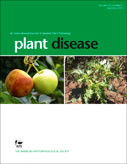The cyst nematodes (Heterodera spp.) are a major group of plant-parasitic nematodes that attack many crop species and cause serious yield losses in major food crops (Jones et al. 2013). Nematodes in the genus Heterodera occur in all major cereal production areas in the Mediterranean Basin (Dababat et al. 2015). In June 2016, six soil samples were collected from durum wheat (Triticum durum) fields of Guellal (36°2′7″ N; 5°20′12″ E), Hammam Sokhna (36°01′09″ N; 5°54′30″ E), Ain Arnat (36°11′1″ N; 5°18′38″ E), Seriana (35°41′37″ N; 6°11′12″ E), Sebaine (33°39′0″ N; 0°12′0″ E), and Maghnia (34°51′42″ N; 1°43′50″ W), located in the Algerian provinces of Setif, Batna, Tiaret, and Tlemcen. The surveyed wheat fields had stunted patches, poor plant growth, chlorotic lower leaves, and few or no tillers. Cysts were extracted from the soil using a Fenwick can technique (Fenwick 1940) and identified. Morphologically, cysts were rounded, deep yellow to brown, with a thick subcrystalline layer, small vulval cone, bifenestrate, two almost circular semifenestrates separated from each other by a rather wide vulval bridge, vulval slit obviously covered by a flap, and bullae present at the underbridge level. Cysts also displayed a strong underbridge with pronounced thickening in the middle and bifurcation at both ends. Measurements (range, mean ± SD) of cysts (n = 10) were as follows: body length (425 to 638 µm, 525.7 ± 76 µm); body width (312 to 475 µm, 365.8 ± 51 µm); fenestra length (56 to 64 µm, 60 ± 2.9 µm); fenestra width (22 to 29 µm, 25.6 ± 2.2 µm); underbridge (83 to 102 µm, 94.5 ± 5.5 µm); and vulval slit (15 to 21 µm, 17.2 ± 2 µm). J2 (obtained after crushed cysts, n = 11) measurements were as follows: body length (425 to 472 µm, 450.9 ± 16.6 µm); stylet (23 to 26 µm, 24.2 ± 1.1 µm); tail (50 to 60 µm, 53.6 ± 3 µm); and hyaline tail terminal (31 to 37 µm, 34 ± 1.8 µm). Values of the morphological and morphometrical characters of the six populations were within the range of Heterodera hordecalis, as reported by Tanha Maafi et al. (2007). The internal transcribed spacer region was used for molecular analysis. DNA was extracted from individual juveniles (n = 3) from different cysts (Holterman et al. 2006). Sequencing was performed using primers TW81 and AB28 (De Ley et al. 1999). The sequences obtained (GenBank accession nos. KX574287, KX574289, KX574307, KX574309, KX574293, and KX574306) were 99 to 100% similar to other H. hordecalis populations. To verify nematode viability, single 5-week-old seedlings of the durum wheat variety (Capa) were grown in pots. Pots were inoculated with 500 eggs and juveniles and left to grow for 9 weeks under growth chamber condition at 22°C. Then, cysts were extracted from both soil and root and an average of 92 cysts (n = 3) were recovered, proving that this nematode multiplies on this host. These morphological and molecular analyses as well as the bioassay test confirmed the identity of the nematode species as H. hordecalis. This nematode can cause considerable damage to wheat, one of Algeria’s main cereal crops. Thus, action should be taken to prevent spread to other regions and provinces. To our knowledge, this detection represents a new record of H. hordecalis in Algeria.

